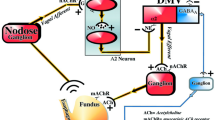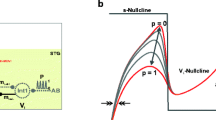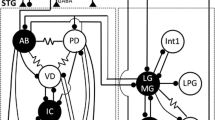Abstract
The buccal ganglia of the mollusc, Lymnaea stagnalis, contain two distinct but interacting rhythm-generating units: the central pattern generator for the buccal rhythm and nitrergic B2 neurons controlling gut motility. Nitric oxide (NO) has previously been demonstrated to be involved in the activation of the buccal rhythm. Here, we found that NO-generating substances (SNP and SNAP) activated the buccal rhythm while slowing the endogenous rhythm of B2 bursters. The inhibitor of NO-synthase, L-NNA, the NO scavenger PTIO, or the inhibitor of soluble guanylyl cyclase, ODQ, each produced opposite, depolarising effects on the B2 neuron. In isolated B2 cells, only depolarising effects of substances interfering with NO production or function (PTIO, L-NNA and ODQ) were detected, whereas the NO donors had no hyperpolarising effects. However, when an isolated B2 cell was placed close to its initial position in the ganglion, hyperpolarising effects could be obtained with NO donors. This indicates that extrasynaptic release of some unidentified factor(s) mediates the hyperpolarising effects of NO donors on the B2 bursters. The results suggest that NO is involved in coordination between the radula and foregut movements and that the effects of NO are partially mediated by the volume chemical neurotransmission of as yet unknown origin.











Similar content being viewed by others
Abbreviations
- L-NNA:
-
N-Nitro-l-arginine
- ODQ:
-
1H-[1,2,4]oxadiazolo[4,3-a]quinoxalin-1-one
- PTIO:
-
2-Phenyl-4,4,5,5-tetramethylimidazonine-l-oxyl-3-oxide
- SNAP:
-
s-Nitroso-N-acetylpenicillamine
- SNP:
-
Sodium nitroprusside
References
Addabbo F, Ratliff B, Park HC, Kuo MC, Ungvari Z, Csiszar A, Krasnikov B, Sodhi K, Zhang F, Nasjletti A, Goligorsky MS (2009) The Krebs cycle and mitochondrial mass are early victims of endothelial dysfunction: proteomic approach. Am J Pathol 174:34–43
Agnati LF, Bjelke B, Fuxe K (1995) Volume versus wiring transmission in the brain: a new theoretical frame for neuropsychopharmacology. Med Res Rev 15:33–45
Agnati LF, Leo G, Zanardi A, Genedani S, Rivera A, Fuxe K, Guidolin D (2006) Volume transmission and wiring transmission from cellular to molecular networks: history and perspectives. Review. Acta Physiol (Oxf) 187:329–344
Arshavsky YUI, Deliagina TG, Gelfand IM, Orlovsky GN, Panchin YV, Pavlova GA, Popova LB (1988) Non-synaptic interaction between neurons in mollusc. Comp Biochem Physiol 91C:199–203
Benjamin PR, Rose RM (1979) Central generation of bursting in the feeding system of the snail, Lymnaea stagnalis. J Exp Biol 80:93–118
Bruns D, Jahn R (1995) Real-time measurements of transmitter release from single synaptic vesicles. Nature 377:62–65
Bunin MA, Wightman RM (1998) Quantitative evaluation of 5-hydroxytryptamine (serotonin) neuronal release and uptake: an investigation of extrasynaptic transmission. J Neurosci 18:4854–4860
Chen G, Gavin PF, Luo G, Ewing AG (1995) Observation and quantitation of exocytosis from the cell body of a fully developed neuron in Planorbis corneus. J Neurosci 15:7747–7755
Chen XW, Mu Y, Huang HP, Guo N, Zhang B, Fan SY, Xiong JX, Wang SR, Xiong W, Huang W, Liu T, Zheng LH, Zhang CX, Li LH, Yu ZP, Hu ZA, Zhou Z (2008) Hypocretin-1 potentiates NMDA receptor-mediated somatodendritic secretion from locus ceruleus neurons. J Neurosci 28:3202–3208
Chistopolsky IA, Sakharov DA (2003) Non-synaptic integration of neuron somata in the snail CNS. Neurosci Behav Physiol 33:295–300
De-Miguel FF, Trueta C (2005) Synaptic and extrasynaptic secretion of serotonin. Cell Mol Neurobiol 25:297–312
Dyakonova TL (1991) Neurophysiological evidence for involvement of endogenous opioids in generation of central motor rhythms in Helix and Clione. In: Winlow W, Vinogradova OS, Sakharov DS (eds) Signal molecules and behaviour. Manchester University Press, Manchester, New York, pp 61–73
Dyakonova TL, Dyakonova VE (2008a) Electrical activity of NO-producing neuron depends on NO level. Bull Exp Biol Med 145:665–668
Dyakonova TL, Dyakonova VE (2008b) Possible involvement of nitric oxide in coordination of buccal feeding rhythm and gut motility in Lymnaea stagnalis. Acta Biol Hung 59:33–37
Dyakonova VE, Chistopolsky IA, Dyakonova TL, Vorontsov DD, Sakharov DA (2009) Direct and decarboxylation-dependent effects of neurotransmitter precursors on firing of isolated monoaminergic neurons. J Comp Physiol A Neuroethol Sens Neural Behav Physiol 195:515–527
Elliott CJ, Susswein AJ (2002) Comparative neuroethology of feeding control in molluscs. Review. J Exp Biol 205:877–896
Elliott CJH, Vehovszky A (2000) Polycyclic neuromodulation of the feeding rhythm of the pond snail Lymnaea stagnalis by the intrinsic octopaminergic interneuron, OC. Brain Res 887:63–69
Elphick MR, Kemenes G, Staras K, O’Shea M (1995) Behavioral role for nitric oxide in chemosensory activation of feeding in a mollusc. J Neurosci 15:7653–7664
Goldstein S, Russo A, Samuni A (2003) Reactions of PTIO and Carboxy-PTIO with NO, NO2, and O2. J Biol Chem 278:50949–50955
Huang S, Kerschbaum HH, Engel E, Hermann A (1997) Biochemical characterization and histochemical localization of nitric oxide synthase in the nervous system of the snail, Helix pomatia. J Neurochem 69:2516–2528
Huang S, Kerschbaum HH, Hermann A (1998) Nitric oxide-mediated cGMP synthesis in Helix neural ganglia. Brain Res 780:329–336
Jaffe EH, Marty A, Schulte A, Chow RH (1998) Extrasynaptic vesicular transmitter release from the somata of substantia nigra neurons in rat midbrain slices. J Neurosci 18:3548–3553
Jansson A, Mazel T, Andbjer B, Rosen L, Guidolin D, Zoli M, Sykova E, Agnati LF, Fuxe K (1999) Effects of nitric oxide inhibition on the spread of biotinylated dextran and on extracellular space parameters in the neostriatum of the male rat. Neuroscience 91:69–80
Kemenes G, Staras K, Benjamin PR (2001) Multiple types of control by identified interneurons in a sensory-activated rhythmic motor pattern. J Neurosci 21:2903–2911
Kiss JP, Zsilla G, Vizi ES (2004) Inhibitory effect of nitric oxide on dopamine transporters: interneuronal communication without receptors. Neurochem Int 45:485–489
Kobayashi S, Sadamoto H, Ogawa H, Kitamura Y, Oka K, Tanishita K, Ito E (2000) Nitric oxide generation around buccal ganglia accompanying feeding behavior in the pond snail, Lymnaea stagnalis. Neurosci Res 38:27–34
Koh H-Y, Jacklet JW (1999) Nitric oxide stimulates cGMP production and mimics synaptic responses in metacerebral neurons of Aplysia. J Neurosci 19:3818–3826
Korneev SA, Piper MR, Picot J, Phillips R, Korneeva EI, O’Shea M (1998) Molecular characterization of NOS in a mollusc: expression in a giant modulatory neuron. J Neurobiol 35:65–71
Korneev SA, Kemenes I, Straub V, Staras K, Korneeva EI, Kemenes G, Benjamin PR, O’Shea M (2002) Suppression of nitric oxide (NO)-dependent behavior by double-stranded RNA-mediated silencing of a neuronal NO synthase gene. J Neurosci 22:227–232
Moroz LL, Park Ji-Ho, Winlow W (1993) Nitric oxide activates buccal motor patterns in Lymnaea stagnalis. Neuroreport 4:643–646
Moroz LL, Turner RW, Winlow W, Bulloch AG, Lukowiak K, Syed NI (1994) Nitric oxide synthase-immunoreactive cells in the CNS and periphery of Lymnaea. Neuroreport 5:1277–1280
Moroz LL, Dahlgren RL, Boudko D, Sweedler JV, Lovell P (2005) Direct single cell determination of nitric oxide synthase related metabolites in identified nitrergic neurons. J Inorg Biochem 99:929–939
Park JH, Straub VA, O’Shea M (1998) Anterograde signaling by nitric oxide: characterization and in vitro reconstitution of an identified nitrergic synapse. J Neurosci 18:5463–5476
Perry SJ, Straub VA, Kemenes G, Santama N, Worster BM, Burke JF, Benjamin PR (1998) Neural modulation of gut motility by myomodulin peptides and acetylcholine in the snail Lymnaea. J Neurophysiol 79:2460–2474
Sadamoto H, Hatakeyama D, Kojima S, Fujito S, Ito E (1998) Histochemical study on the relation between NO-generative neurons and central circuitry for feeding in the pond snail, Lymnaea stagnalis. Neurosci Res 32:57–63
Sakharov DA (1990) Neurotransmitter diversity: functional significance. Zh Evol Biokhim Fiziol 26:733–750
Sem’yanov AV (2005) Diffusional extrasynaptic neurotransmission via glutamate and GABA. Neurosci Behav Physiol 35:253–266
Spencer GE, Lukowiak K, Syed NI (2000) Transmitter-receptor interactions between growth cones of identified Lymnaea neurons determine target cell selection in vitro. J Neurosci 20:8077–8086
Staras K, Kemenes G, Benjamin PR (1998) Pattern-generating role for motoneurons in a rhythmically active neuronal network. J Neurosci 18:3669–3688
Straub VA, Grant J, O’Shea M, Benjamin PR (2007) Modulation of serotonergic neurotransmission by nitric oxide. J Neurophysiol 97:1088–1099
Vizi ES, Kiss JP, Lendvai B (2004) Nonsynaptic communication in the central nervous system. Review. Neurochem Int 45:443–451
Zayas RM, Trimmer BA (2007) Characterization of NO/cGMP-mediated responses in identified motoneurons. Cell Mol Neurobiol 27:191–209
Acknowledgments
We thank Prof. D.A. Sakharov, Prof. I.S. Zakharov and our colleagues from the Laboratory of Comparative Physiology for helpful comments on this work. It is supported by the grant RFBR 08-04-00120.
Author information
Authors and Affiliations
Corresponding author
Rights and permissions
About this article
Cite this article
Dyakonova, V.E., Dyakonova, T.L. Coordination of rhythm-generating units via NO and extrasynaptic neurotransmitter release. J Comp Physiol A 196, 529–541 (2010). https://doi.org/10.1007/s00359-010-0541-5
Received:
Revised:
Accepted:
Published:
Issue Date:
DOI: https://doi.org/10.1007/s00359-010-0541-5




